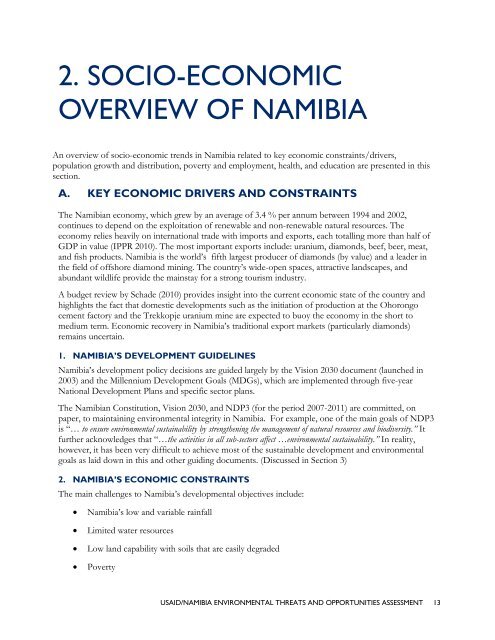usaid/nambia environmental threats and opportunities assessment
usaid/nambia environmental threats and opportunities assessment
usaid/nambia environmental threats and opportunities assessment
Create successful ePaper yourself
Turn your PDF publications into a flip-book with our unique Google optimized e-Paper software.
2. SOCIO-ECONOMIC<br />
OVERVIEW OF NAMIBIA<br />
An overview of socio-economic trends in Namibia related to key economic constraints/drivers,<br />
population growth <strong>and</strong> distribution, poverty <strong>and</strong> employment, health, <strong>and</strong> education are presented in this<br />
section.<br />
A. KEY ECONOMIC DRIVERS AND CONSTRAINTS<br />
The Namibian economy, which grew by an average of 3.4 % per annum between 1994 <strong>and</strong> 2002,<br />
continues to depend on the exploitation of renewable <strong>and</strong> non-renewable natural resources. The<br />
economy relies heavily on international trade with imports <strong>and</strong> exports, each totalling more than half of<br />
GDP in value (IPPR 2010). The most important exports include: uranium, diamonds, beef, beer, meat,<br />
<strong>and</strong> fish products. Namibia is the world’s fifth largest producer of diamonds (by value) <strong>and</strong> a leader in<br />
the field of offshore diamond mining. The country’s wide-open spaces, attractive l<strong>and</strong>scapes, <strong>and</strong><br />
abundant wildlife provide the mainstay for a strong tourism industry.<br />
A budget review by Schade (2010) provides insight into the current economic state of the country <strong>and</strong><br />
highlights the fact that domestic developments such as the initiation of production at the Ohorongo<br />
cement factory <strong>and</strong> the Trekkopje uranium mine are expected to buoy the economy in the short to<br />
medium term. Economic recovery in Namibia’s traditional export markets (particularly diamonds)<br />
remains uncertain.<br />
1. NAMIBIA’S DEVELOPMENT GUIDELINES<br />
Namibia’s development policy decisions are guided largely by the Vision 2030 document (launched in<br />
2003) <strong>and</strong> the Millennium Development Goals (MDGs), which are implemented through five-year<br />
National Development Plans <strong>and</strong> specific sector plans.<br />
The Namibian Constitution, Vision 2030, <strong>and</strong> NDP3 (for the period 2007-2011) are committed, on<br />
paper, to maintaining <strong>environmental</strong> integrity in Namibia. For example, one of the main goals of NDP3<br />
is “… to ensure <strong>environmental</strong> sustainability by strengthening the management of natural resources <strong>and</strong> biodiversity.” It<br />
further acknowledges that “…the activities in all sub-sectors affect …<strong>environmental</strong> sustainability.” In reality,<br />
however, it has been very difficult to achieve most of the sustainable development <strong>and</strong> <strong>environmental</strong><br />
goals as laid down in this <strong>and</strong> other guiding documents. (Discussed in Section 3)<br />
2. NAMIBIA’S ECONOMIC CONSTRAINTS<br />
The main challenges to Namibia’s developmental objectives include:<br />
<br />
<br />
<br />
<br />
Namibia’s low <strong>and</strong> variable rainfall<br />
Limited water resources<br />
Low l<strong>and</strong> capability with soils that are easily degraded<br />
Poverty<br />
USAID/NAMIBIA ENVIRONMENTAL THREATS AND OPPORTUNITIES ASSESSMENT 13

















